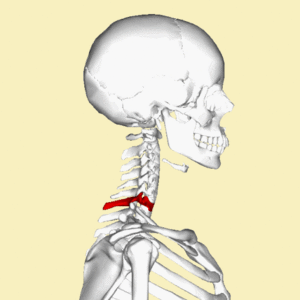Vertebra Prominens: Difference between revisions
No edit summary |
No edit summary |
||
| Line 7: | Line 7: | ||
== Introduction == | == Introduction == | ||
[[File:C7 animation (1).gif|right|frameless]] | [[File:C7 animation (1).gif|right|frameless]] | ||
Vertebra prominens is the name of the seventh cervical vertebra. The most | Vertebra prominens is the name of the seventh cervical vertebra. | ||
The 7th [[Cervical Vertebrae|cervical vertebra]] (C7) is the largest and most inferior vertebra in the neck region. Unlike the other cervical vertebrae, the C7 has a large spinous process that protrudes posteriorly toward the [[skin]] at the back of the [[Cervical Anatomy|neck]]. | |||
This spinous process can be easily seen and felt at the base of the neck, making it a prominent landmark of the skeleton (giving the C7 the name vertebra prominens). | |||
The C7 is located in the spinal column inferior to the 6th cervical (C6) vertebra and superior to the first thoracic (T1) vertebrasurface, hence the name. | |||
Image 1: C7 animation gif | Image 1: C7 animation gif | ||
== | == Features == | ||
As the transitional vertebra between the cervical and thoracic regions, the C7 has some features of both the cervical and thoracic vertebrae. | |||
# Like the C3 through C6 vertebrae, C7 has a thicker area of bone called the '''Body''', located anterior to the vertebral foramen. The body of C7 supports the collective weight of the head and neck. | |||
# '''Lateral Facets,''' allow C7’s body to form joints with the C6 vertebra above it and the T1 below it. The facets surrounding the body provide both stability and flexibility to the neck. | |||
# Fibrocartilaginous [[Intervertebral disc|intervertabral discs]] above and below the C7’s body provide cushioning. The discs surrounding the body provide both stability and flexibility to the neck. | |||
== Other structures == | == Other structures == | ||
Revision as of 01:34, 4 November 2021
Original Editor - Rachael Lowe
Top Contributors - Lucinda hampton, Admin, Kim Jackson and WikiSysop
Introduction[edit | edit source]
Vertebra prominens is the name of the seventh cervical vertebra.
The 7th cervical vertebra (C7) is the largest and most inferior vertebra in the neck region. Unlike the other cervical vertebrae, the C7 has a large spinous process that protrudes posteriorly toward the skin at the back of the neck.
This spinous process can be easily seen and felt at the base of the neck, making it a prominent landmark of the skeleton (giving the C7 the name vertebra prominens).
The C7 is located in the spinal column inferior to the 6th cervical (C6) vertebra and superior to the first thoracic (T1) vertebrasurface, hence the name.
Image 1: C7 animation gif
Features[edit | edit source]
As the transitional vertebra between the cervical and thoracic regions, the C7 has some features of both the cervical and thoracic vertebrae.
- Like the C3 through C6 vertebrae, C7 has a thicker area of bone called the Body, located anterior to the vertebral foramen. The body of C7 supports the collective weight of the head and neck.
- Lateral Facets, allow C7’s body to form joints with the C6 vertebra above it and the T1 below it. The facets surrounding the body provide both stability and flexibility to the neck.
- Fibrocartilaginous intervertabral discs above and below the C7’s body provide cushioning. The discs surrounding the body provide both stability and flexibility to the neck.
Other structures[edit | edit source]
The transverse processes are of considerable size, their posterior roots are large and prominent, while the anterior are small and faintly marked; the upper surface of each has usually a shallow sulcus for the eighth spinal nerve, and its extremity seldom presents more than a trace of bifurcation.
The transverse foramen may be as large as that in the other cervical vertebrae, but is generally smaller on one or both sides; occasionally it is double, sometimes it is absent. On the left side it occasionally gives passage to the vertebral artery; more frequently the vertebral vein traverses it on both sides; but the usual arrangement is for both artery and vein to pass in front of the transverse process, and not through the foramen.
Anomalies[edit | edit source]
Sometimes the anterior root of the transverse process attains a large size and exists as a separate bone, which is known as a Cervical Rib. These ribs are usually small, but may occasionally compress blood vessels (such as the subclavian artery or subclavian vein) or nerves in the Brachial plexus, causing pain, numbness, tingling, and weakness in the upper limb, a condition known as Thoracic Outlet Syndrome (TOS).







